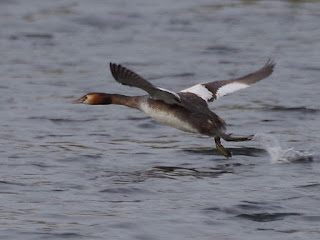A Wren was scolding noisily and hopping around in a tree near the bridge.
Carrion Crows use this rattling call as a signal to mob a predator such as a hawk. But I couldn't see a predator overhead, and no other crow seemed to respond to the call.
But this crow was looking around nervously, so it must have reacted to the rattling call.
Today's search for the Firecrest produced calls from two of them on the west side of the nursery, about 100 yards up from the southwest corner. But still the only birds that came into view were Goldcrests.
The remaining fruit on the rowan trees on Buck Hill attracted several Blackbirds ...
... and a single Mistle Thrush.
A Jay came down to take a peanut from my fingers. This is not a good video, as I am still working to get the subject right. But the slow motion does show that when a Jay takes the nut, it uses its beak to take it and not its feet.
Black-Headed Gulls seem to use this display both for courtship and for rivalry. In this case it must have been rivalry, as one ended up attacking the other.
A pair of Egyptian Geese at the Dell chased another pair, separating them. One took refuge behind the railings ...
... while the victors displayed, quacking and panting loudly.
A Greylag at the Dell restaurant won a whole bread roll and hurried off to eat it away from the gulls.
The Black Swan came onshore at the Vista, something he can do quite easily but is a real effort for the bigger and clumsier resident pair of Mute Swans, who chose to stay put and stare at him enviously as he enjoyed his treat of birdseed.
A Great Crested Grebe flew down the Serpentine.

























































